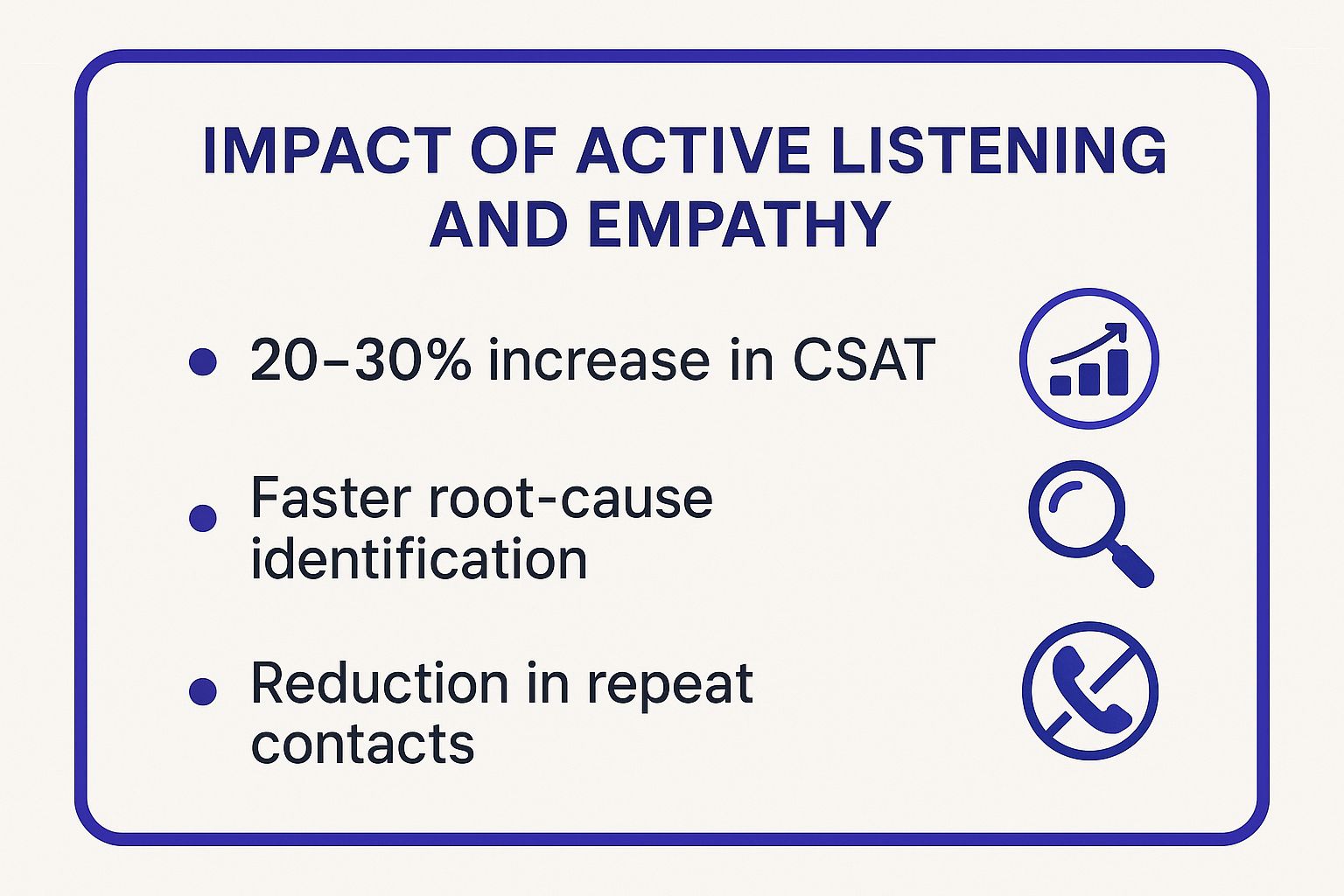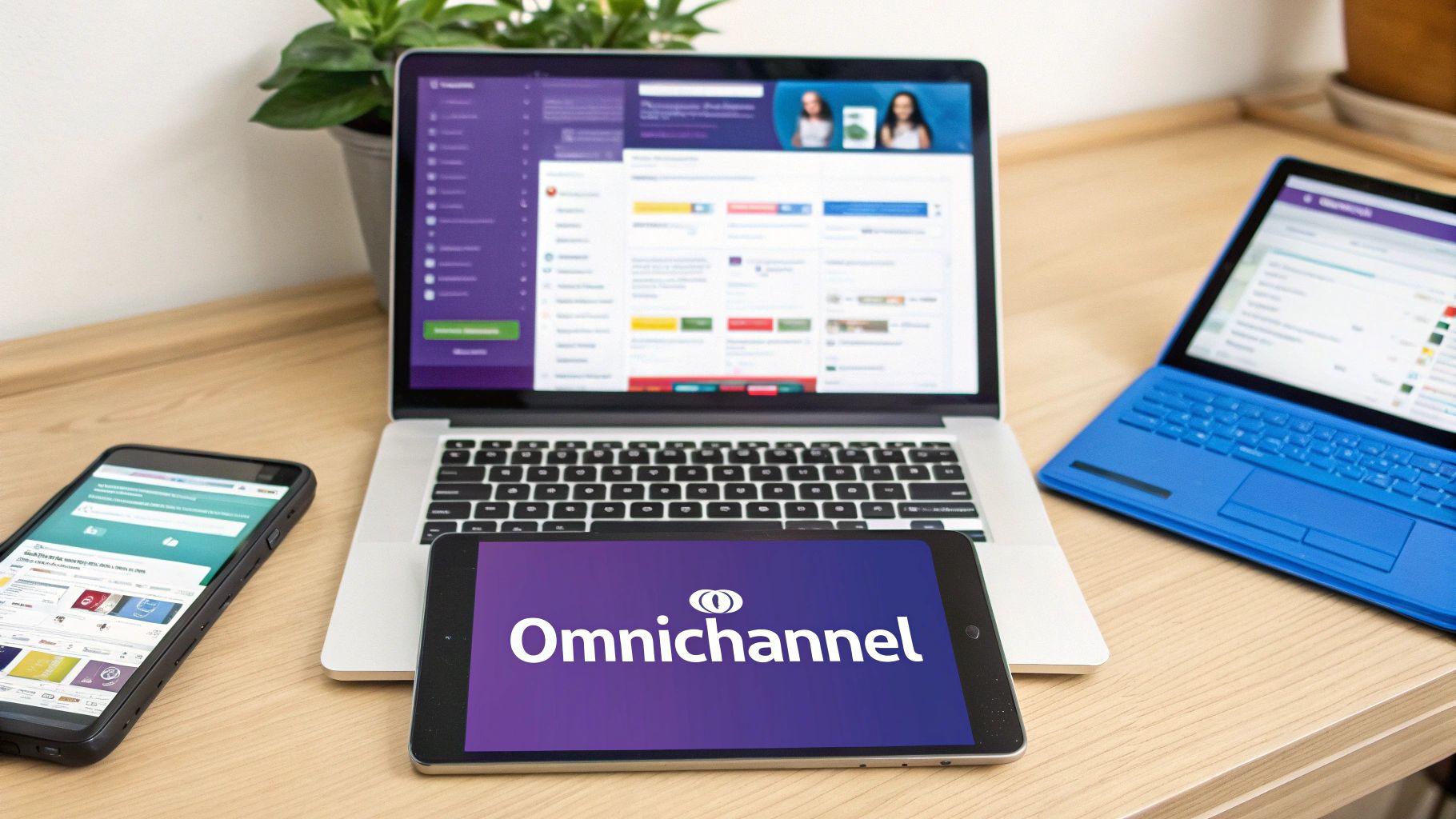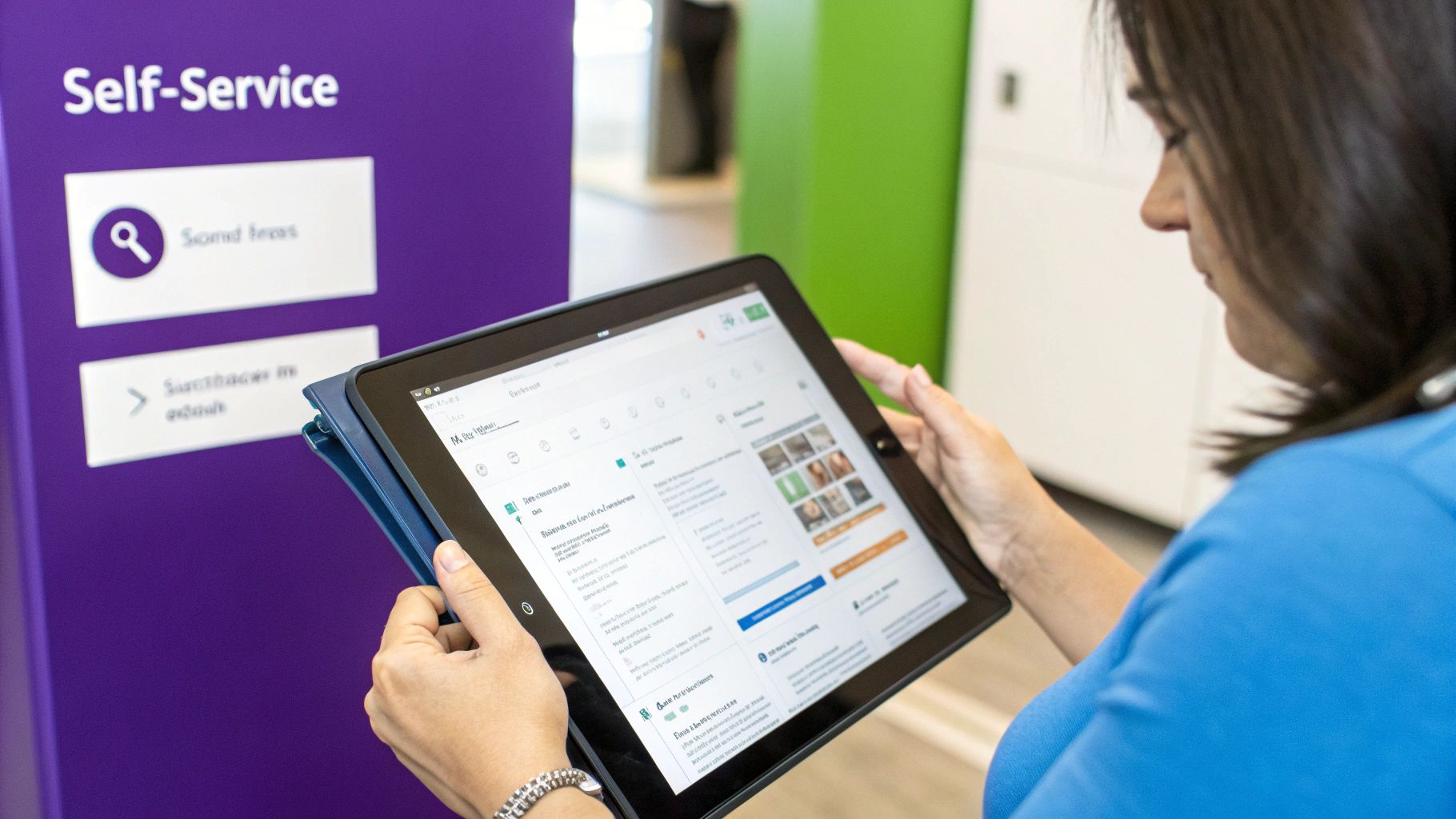In a crowded marketplace, exceptional service is the ultimate differentiator. Customers today expect more than just answers to their questions; they demand fast, personalized, and empathetic interactions across every channel they use. Simply meeting baseline expectations is no longer enough to secure retention and drive growth. The companies that thrive are those that view support not as a cost center, but as a core component of the customer experience.
This guide moves beyond generic advice to provide a detailed roadmap for implementing 10 critical customer service best practices. These are the strategies that leading companies use to transform standard interactions into memorable, loyalty-building experiences. We will explore actionable tactics for everything from mastering active listening and ensuring omnichannel consistency to leveraging proactive engagement and empowering your team. To move beyond standard support and deliver these exceptional experiences, investing in comprehensive tools is paramount; you can explore a breakdown of the 12 Best Customer Engagement Solutions to see how technology facilitates these strategies.
By adopting these proven practices, you'll be equipped to not just satisfy, but truly delight your customers. This list is your blueprint for building a world-class service operation that becomes a powerful engine for business growth.
Active listening is more than just hearing words; it's a fundamental customer service best practice that involves fully concentrating on, understanding, and responding to what customers are saying. When combined with empathy, it transforms a transactional interaction into a relational one. This approach, championed by leaders like Zappos’ Tony Hsieh, focuses on making customers feel genuinely heard and valued, which is crucial for effective problem resolution and building lasting loyalty. Instead of simply waiting for a turn to speak, agents using this technique focus on the customer's emotional state as much as their technical issue.
To integrate this practice, train your team to use reflective phrases like, "What I'm hearing is..." or "It sounds like you're feeling frustrated, and I understand why." This validates the customer's feelings and confirms the agent’s understanding. Role-playing difficult scenarios and implementing a "pause before responding" culture can help agents move from reactive to thoughtful replies. Companies like Ritz-Carlton excel by training staff to anticipate unexpressed needs, turning a good experience into a memorable one.
The infographic below highlights the tangible business impact of embedding active listening and empathy into your customer service strategy.

These metrics show that empathetic listening isn't just a soft skill; it's a powerful driver for operational efficiency and customer satisfaction.
Researcher Brené Brown explains the critical difference between empathy and sympathy, which is a key concept for service teams. Watching her explanation can provide a deeper understanding for your team.
Omnichannel consistency is a critical customer service best practice that ensures a seamless, integrated experience across all communication channels, including phone, email, chat, social media, and in-person interactions. This approach views the customer journey as a single, holistic experience, allowing customers to switch between channels without losing context or having to repeat information. Pioneered by firms like Salesforce and Zendesk, it moves beyond multichannel support by unifying all touchpoints into one cohesive conversation.

This unified strategy is essential for modern customer service, as it directly impacts satisfaction and retention by eliminating friction and frustration from the support process.
To build a truly omnichannel experience, invest in a robust CRM system that centralizes customer data from all channels. Map the complete customer journey to identify and connect critical touchpoints, ensuring a smooth transition for the user. Companies like Disney excel at this with their My Disney Experience app, which integrates park visits, hotel stays, and customer support into one seamless platform.
This approach requires more than just technology; it demands a shift in mindset. Develop channel-agnostic training programs that empower support staff to handle inquiries regardless of their origin.
Start by establishing clear and consistent service level agreements (SLAs) for every channel. Regularly audit the experience by using mystery shoppers to test channel transitions and identify integration gaps. For example, a customer might start a query on a web chat and need to escalate to a phone call. In a true omnichannel system, the phone agent would have the full chat transcript instantly available.
This practice requires a deep integration of your systems and teams. Use customer feedback loops to pinpoint where handoffs are failing and refine your processes accordingly to deliver the seamless service modern consumers expect.
Proactive customer service is the practice of anticipating customer needs and resolving potential issues before they escalate or even occur. Instead of waiting for a customer to report a problem, this forward-thinking approach uses data and customer insights to get ahead of friction points. This customer service best practice, championed by figures like Amazon's Jeff Bezos, shifts the support model from reactive problem-solving to proactive experience enhancement, showing customers you are looking out for them. This demonstrates a deep commitment to the customer journey, significantly boosting satisfaction and loyalty.
Integrating this practice requires a shift to data-driven decision-making. Start by implementing monitoring systems to detect service disruptions or common user friction points immediately. Use this data to create triggered communications based on specific behaviors; for example, if a user repeatedly visits a help page but doesn't find a solution, a proactive chat invitation can be triggered. Amazon excels at this by notifying customers of delivery delays before the package is even late, often including a small credit as a gesture of goodwill. Similarly, Microsoft Azure sends alerts about potential service degradation with pre-emptive mitigation steps.
A powerful way to be proactive is by creating a comprehensive knowledge base or educational content that addresses common questions before they are asked. Use predictive analytics and AI to identify customers who might be at risk of churning or encountering a specific issue and reach out with personalized support.
To ensure your outreach is helpful, not intrusive:
First Contact Resolution (FCR) is the practice of completely resolving a customer's issue during their initial interaction, eliminating the need for follow-up contacts or escalations. This customer service best practice prioritizes empowering frontline staff with the knowledge, tools, and authority to solve problems immediately. Pioneered by research firms like SQM Group, FCR is a critical metric because it directly correlates with customer satisfaction and operational efficiency, reducing the costs associated with repeat calls.
To improve your FCR rate, start by equipping agents with an easily searchable internal knowledge base and comprehensive training. Empower them with the decision-making authority to handle common issues without needing a manager's approval. Southwest Airlines excels here by giving its agents the power to make financial decisions up to a certain limit to resolve customer problems on the spot. Tracking FCR as a primary KPI alongside customer satisfaction scores is essential for measuring success.
Analyzing the root causes of repeat contacts is key to identifying gaps in your processes or training. If multiple customers call about the same confusing policy, it’s a sign that the policy or its documentation needs clarification. Implementing post-interaction surveys that specifically ask, "Was your issue resolved in this first contact?" provides direct feedback. Remember to balance FCR with quality; agents shouldn't rush complex issues just to close a ticket, as this can lead to even greater frustration down the line.
Personalization at scale is a crucial customer service best practice that leverages data, automation, and AI to deliver tailored experiences to a broad audience. It moves beyond simple tactics like using a customer's first name in an email to providing highly relevant and contextual support. Popularized by pioneers like Netflix’s Reed Hastings and Amazon’s Jeff Bezos, this approach uses customer history and behavior to anticipate needs, offer relevant solutions, and make every individual feel uniquely understood. The goal is to create a one-to-one relationship, even when serving millions.
To begin, start with foundational data like purchase history and then gradually incorporate more complex behavioral insights. For example, Amazon’s recommendation engine, which drives a significant portion of its sales, suggests products based on past browsing and buying habits. Similarly, Spotify creates its "Discover Weekly" playlists for millions of users by analyzing individual listening patterns. This shows that effective personalization adds tangible value to the customer experience, making interactions more efficient and enjoyable.
For teams looking to integrate this strategy, the key is to start small and build momentum. Focus on a few high-impact areas first.
Employee empowerment is a critical customer service best practice that involves giving frontline staff the authority, resources, and trust to make decisions without constant managerial approval. This approach, championed by leaders like Horst Schulze of Ritz-Carlton and Tony Hsieh of Zappos, recognizes that engaged employees are the key to delivering superior customer experiences. By providing autonomy and fostering accountability, companies create a culture where staff feel valued and are motivated to resolve issues creatively and effectively.
To integrate this practice, establish clear guidelines that define the scope of employee autonomy, such as setting specific dollar limits for problem resolution. Ritz-Carlton famously allows each employee to spend up to $2,000 per guest to solve an issue, a policy that builds both employee confidence and customer loyalty. This level of trust transforms agents from script-followers into genuine problem-solvers.
This infographic highlights the strong correlation between employee engagement and key business outcomes, reinforcing its importance.

These metrics demonstrate that investing in your team's engagement directly translates to a stronger bottom line and happier customers.
Begin by hiring for attitude and emotional intelligence, then train for specific skills. Create an environment of psychological safety where staff feel secure taking calculated risks to please customers. Publicly celebrate empowerment success stories to reinforce desired behaviors and provide ongoing coaching rather than punitive oversight. As Nordstrom's famous one-rule handbook states, "Use good judgment in all situations," placing immense trust in their team to do what's right for the customer.
Empowering customers to find their own solutions is a cornerstone of modern customer service best practices. Self-service options, such as comprehensive knowledge bases, FAQs, and community forums, allow customers to resolve issues independently and on their own schedule. This approach, championed by firms like Zendesk and Salesforce, not only meets the demand for immediate answers but also frees up human agents to handle more complex inquiries. When customers can quickly find information themselves, it significantly reduces support ticket volume and enhances their sense of competence and satisfaction.
To build an effective self-service portal, start by analyzing your most common support tickets to identify which content to create first. Companies like Intuit use interactive decision trees in their TurboTax support to guide users through complex scenarios, while Microsoft’s support site leverages AI to recommend relevant articles. Prioritize clear, jargon-free language and supplement text with visual aids like screenshots and video tutorials. A powerful search function is critical for discoverability, and it's equally important to provide a clear, easy-to-find escalation path to a human agent when self-service isn't enough.
A self-service portal is not a "set it and forget it" project. Regular maintenance is key to its success and long-term value.
This continuous improvement loop ensures your knowledge base remains a reliable and valuable resource for your customers.
Real-time feedback collection is a crucial customer service best practice that involves gathering customer input immediately following service interactions and acting on it swiftly. This approach, championed by experience management platforms like Medallia and Qualtrics, creates a powerful closed-loop system. Instead of waiting for quarterly reports, teams can address issues, coach agents, and make strategic adjustments based on immediate, relevant data, showing customers their voice directly influences business operations.

This method transforms feedback from a passive metric into an active tool for continuous improvement and customer retention.
To effectively integrate this practice, deploy short, timely surveys immediately after an interaction is resolved. For instance, Uber requests a rating right after a ride, and Apple Stores use on-the-spot iPad surveys after Genius Bar appointments. This provides instant data that can be used for agent coaching the very next day.
Key steps for implementation include:
Finding the right balance between speed and quality is a critical customer service best practice that separates good service from great service. Customers expect prompt responses, but they also demand effective solutions. Sacrificing thoroughness for speed leads to repeat contacts and frustration, while ignoring speed can make customers feel undervalued. This practice, championed by efficiency-focused leaders like Amazon and quality-first brands like Zappos, involves optimizing processes to deliver swift, accurate, and complete resolutions. The goal is to be both fast and right, ensuring the first contact is often the only one needed.
To implement this, start by setting clear, channel-specific Service Level Agreements (SLAs). A live chat response should be faster than an email reply. Empower agents with tools like unified agent desktops and robust knowledge bases to find information quickly. Use smart routing to direct complex inquiries to specialized agents, preventing delays. For instance, Chewy combines a rapid average response time of two minutes with personalized touches, proving that efficiency and heartfelt service can coexist. This approach turns a potentially stressful interaction into a positive brand-building moment.
To ensure you aren't sacrificing quality for speed, track metrics in pairs. Analyze how these key performance indicators influence each other to get a complete picture of your team's performance.
Continuous training and development is a crucial customer service best practice that extends beyond initial onboarding. It recognizes that products, customer expectations, and support technologies are constantly evolving, requiring service teams to regularly upskill. This commitment to ongoing education, championed by organizations like the Ritz-Carlton, ensures that agents are always equipped with the latest knowledge, tools, and soft skills to deliver exceptional experiences. Instead of viewing training as a one-time event, this approach embeds learning into the daily operational rhythm.
To integrate this practice, move beyond annual workshops to a more dynamic model. Dedicate specific, non-negotiable time each week for learning activities. Companies like Salesforce have popularized this with platforms like Trailhead, offering gamified, bite-sized learning modules that employees can complete on an ongoing basis. Similarly, the Disney Institute builds on its legendary initial training with continuous development to ensure every "cast member" consistently delivers magical experiences.
Key strategies include:
To ensure your training investment pays off, focus on performance metrics rather than just completion rates. Track improvements in metrics like First Contact Resolution (FCR), Customer Satisfaction (CSAT), and average handling time after specific training modules. Tie learning pathways directly to career advancement opportunities, creating a culture where growth is celebrated and rewarded. This transforms training from a requirement into a powerful tool for professional development and retention.
Navigating the landscape of modern customer service requires more than just good intentions; it demands a strategic and holistic approach. Throughout this guide, we've explored ten foundational customer service best practices, from the human-centric principles of active listening and empathy to the technological leverage of personalization at scale. Each practice, whether it’s achieving omnichannel consistency, empowering your employees, or prioritizing first contact resolution, serves as a critical pillar in building an exceptional customer experience.
The journey doesn't end with simply understanding these concepts. The true challenge, and the greatest opportunity, lies in weaving them into the very fabric of your organization’s culture. The goal is to transition these principles from a checklist of "best practices" into the standard operating procedure, or "business-as-usual." This transformation happens when every team member, from the frontline agent to the CEO, is aligned with a customer-centric vision.
To prevent overwhelm, avoid a complete overhaul overnight. Instead, adopt a phased approach to integrate these strategies effectively:
Mastering these customer service best practices is not merely about reducing churn or improving satisfaction scores. It's about building a resilient brand fortified by genuine customer loyalty. When you consistently deliver fast, empathetic, and personalized support, you create advocates who champion your business. This loyalty becomes a powerful competitive advantage that is difficult for others to replicate. Ultimately, the adoption of these best practices aims to transform customer service from a cost center into a powerful driver of loyalty and growth. To solidify this transformation, it's vital to implement robust strategies like proven customer retention best practices that lock in the gains you’ve made.
By committing to this journey of continuous improvement, you’re not just solving problems; you are building relationships, fostering trust, and creating experiences that customers will remember and reward for years to come.
Ready to elevate your customer experience with intelligent automation? Upcraft provides conversational AI agents that handle inquiries 24/7, personalize interactions, and free up your team to focus on building meaningful customer relationships. Discover how our AI can help you implement these best practices at scale by visiting Upcraft today.
Enter your contact information and Archer will start a conversation with you via text message.